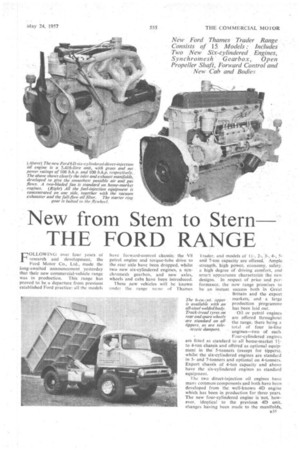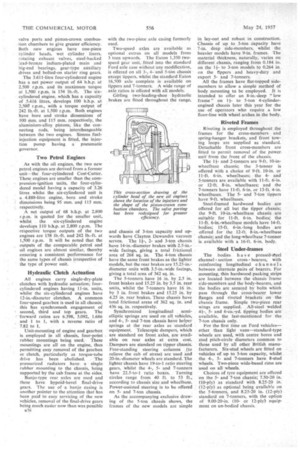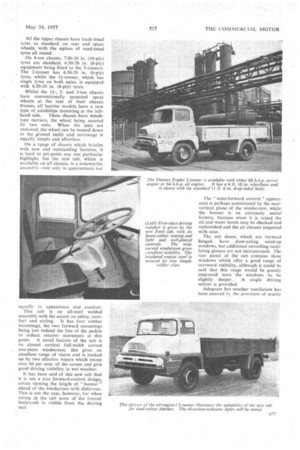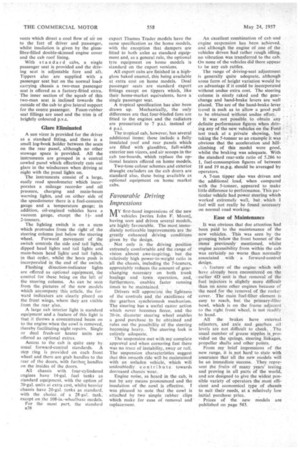New from Stem to Stern THE FORD RANGE
Page 73

Page 74

Page 75

Page 76

If you've noticed an error in this article please click here to report it so we can fix it.
FOLLOWINU over four years of research and development, the Ford Motor Co., Ltd., made the long-awaited announcement yesterday that their new commercial-vehicle range was in production. This range has proved to be a departure from previous established Ford practice: all the models have forward-control chassis; the V8 petrol engine and torque-tube drive to the rear axle have been dropped, whilst two new six-cylindered engines, a synchromesh gearbox, and new axles, wheels and cabs have been introduced.
These new vehicles will be known tinder the range na-ne of Thames I rader. and models of 1.1-, 2-, 3-, 4-, 5and 7-ton capacity are offered. Ample strength, high power, economy, safety, a high degree of driving comfort, and smart appearance characterize the new designs. In respect of price and performance, the new range promises to he an instant success both in Great Britain and the export markets, and a large
is available with an production programme all-steel welded body. has been laid out. Track-tread tyres on Oil or petrol engines rear and spare wheels are offered throughout are stundard on all the range, there being a tippers, as are teletotal of four in-line -scopic dampers. engines—two of each.
Four-cylindered 'engines are fitted as standard to all home-market 1.-1to 4-ton chassis and offered as optional equipment in the 5-tanners (except for tippers). whilst the six-cylindered engines are standard in 5and 7-tonners and optional on 4-tonners. Export chassis of 4-ton capacity and above have the six-cylindered engines as standard equipment.
The two direct-injection oil engines have many common components and both have been developed from the well-known 4D engine which has been in production for three years. The new four-cylindered engine is 'not, however, identical to the previous 4D unit, changes having been made to the manifolds, valve ports and piston-crown combustion chambers to give greater efficiency. Both new engines have one-piece Cylinder heads, wet cylinder liners, rotating exhaust valves, steel-backed lead-bronze indium-Plated main and big-end bearings, gear-type auxiliary drives and bolted-on starter ring gears.
The 3.611-litre four-cylindered engine has a net pawer output of 64 b.h.p. at 2,500 r.p.m. and its maximum torque at 1,500 r.p.m. is 154 lb.-ft. The six-. cylindered engine, which has a capacity of 5.416 litres, develops 100 b.h.p. at 2,50G r.p.m., with a torque output of 242 lb.-ft. at 1,500 r.p.m. Both engines have bore and stroke dimensions of 100 mm. and 115 mm. respectively, the aluminium-alloy pistons, like the connecting rods, being interchangeable between the two engines. Simms fuelinjection equipment is fitted, the injection pump having a pneumatic governor.
Two Petrol Engines
As with the oil engines, the two new petrol engines am derived from a former unit-the four-cylindered Cost-Cutter. These engines are smaller than the compression-ignition units, the four-cylindered model having a capacity of 3.26 litres whilst the six-cylindered unit is a 4.888-litre engine, bore and stroke dimensions being 95 mm. and 115 mm: respectively.
A net output of 68 b.h.p. at 2,800 r.p.m. is quoted for the smaller unit,
whilst . the six-cylindered engine develops 110 b.h.p. at 2,800 r.p.m. The ,respective torque outputs of the two engines are 158 lb,-ft. and 242 lb.-ft. at 1,500 r.p.m. It will be noted that the outputs of the comparable petrol and oil engines are almost similar, thereby ensuring a consistent performance for the same types of chassis irrespective of the type of power unit.
Hydraulic Clutch Actuation
All engines carry single-dry-plate clutches with hydraulic actuation; fourcylindered engines having 11-in, units, whilst the six-eylindered engines have 12-in.-diameter clutches. A common four-speed gearbox is used in all chassis; this has synchromesh engagement of second, third and top gears. The forward ratios are 6.398, 3.092, 1.686 and 1 to 1, with a reverse ratio of 7.82 to 1.
Unit-mounting of engine and gearbox is employed in all chassis, four-point rubber mountings being used. These mountings are all on the engine, thus permitting easy removal of the gearbox or clutch, particularly as torque-tube drive has been abolished. . -The pressurized radiators have a single rubber mounting to the chassis, being supported by the cab frame at the sides.
Banjo-type rear axles are used and these have hypoid-bevel final-drive gears. The use of •a banjo casing is another pointer to the attention that has been paid to easy servicing of the new vehicles, removal of the final-drive gears being much easier now than was possible n36 with the two-piece axle casing formerly used.
Two-speed axles are available as optional extras on all models from 3 tons upwards, The Eaton 1,350 twospeed gear unit, fitted into the standard Ford axle case without any modification, is offered on all 3-, 4and 5-ton chassis except tippers, whilst the standard Eaton 16,500 axle coniplete is available on tippers and 7-tanners. A wide range of axle ratios is offered with all models.
Girling two-leading-shoe hydraulic brakes are fitted throughout the range,
and chassis of 3-ton capacity and upwards have Clayton Dewandre vacuum servos. The 11-, 2and 3-ton chassis have 14-in.-diameter brakes with 2.5-An,wide facings, giving a total frictional area of 268 sq. in. The 4-ton. chassis have the same front brakes as the lighter models, but the rear brakes are 15.25-in.diameter units with 3.5-in.-wide facings, giving a total area of 342 sq. in.
The 5-tanners have 16 in. by 2.5 in. front brakes and 15.25 in. by 3.5 in. rear units, whilst the 7-tonners have 16 in. by 3 in. front brakes and 15.25 in. by 4.25 in. rear brakes. These chassis have total frictional areas of 362 sq. in. and 436 sq. in. respectively.
Synchronized longitudinal semielliptic springs are used on all vehicles, and 4-, 5and 7-ton chassis have helper springs at the rear axles as standard equipment. Telescopic dampers, which are standard on front axles, are available on rear axles at extra cost. . Dampers are standard on tipper chassis. Free-standing steering columns (to relieve the cab of stress) are used and 20-in.-diameter wheels are standard. The lighter chassis have 19-to-1 ratio steering gears, whilst the 4-, 5and 7-tonners have 22.5-to-I ratio boxes. Turning circles range from 40 ft. to 53 ft., according to chassis size and wheelbase. Power-assisted steering is to be offered on 5and 7-ton chassis.
As the accompanying exclusive drawing of the 5-ton chassis shows, the frames of the new models are simple in lay-out and robust in construction. Chassis of up to 3-ton capacity have 7-in, deep side-members, whilst the heavier models have 9-in. frames. The material thickness, naturally, varies on different chassis, ranging from 0.184 in. on the Ifto 3-ton models to 0.264 in. on the tippers and heavy-duty and export 5and 7-tonners.
All the frames have flat-topped sidemembers to allow a simple method of body mounting to be employed. It is intended to offer an 8-in.-deep " low frame" on Ifto 5-ton 4-cylinderengined chassis later this year for the use of operators who require a low floor-line with wheel arches in the body.
Riveted Frames
Riveting is employed throughout the frames for the cross-members and spring-hanger brackets, and front towing loops are supplied as standard. Detachable front cross-members are fitted to permit removal of the power, unit from the front of the chassis.
The Ifand 2-tanners are 9-ft. 10-inwheelbase chassis; the 3-tanner is offered with a choice of 9-ft. 10-in. or 11-ft. 6-in. wheelbases; the 4and 5-tonners are available with 11-ft. 6-in. or 12-ft. 8-in. wheelbases; and the 7-ton ners have 11-ft. 6-in, or 13-ft. 4-in. wheelbases. The 5and 7-ton tippers have 9-ft. wheelbases.
Steel-framed hardwood bodies are offered for all but the tipper chassis; the 9-ft. 10-in.-wheelbase chassis are suitable for 11-ft. 6-in, bodies; the 1l-ft. 6-in.-wheelbase models have 14-ft. bodies; 15-ft. 6-in.-long bodies are offered for the 12-ft. 8-in.-wheelbase chassis; and the long-wheelbase 7-tanner is available with a 16-ft. 6-in. body.
Steel Under-frames The bodies have pressed-Teel channel section cross bearers, with reinforcing longitudinal channels between alternate pairs of bearers. For mounting, thin hardwood packing strips are located between the chassis -frame side-membhrs•and the body-bearers, and the bodies are secured by bolts which pass through the cross-bearer lower flanges and riveted brackets on the chassis frame. Simple two-piece rear wings are supplied. All-steel welded 41-, 5and 6-cu.-yd. tipping bodies are available, the last-mentioned for the 7-ton chassis only.
For the first time on Ford vehiclesother than light vans-standard-type wheels are used, with centre bores and stud pitch-circle diameters common to those used by all other British manufacturers. Six-stud wheels are fitted on vehicles of up to 3-ton capacity, whilst the 4-, 5and 7-tanners have 8-stud wheels. Two-piece wide-based rims are used on all wheels.
Choices of tyre equipment are offered on the 5and 7-ton chassis; 7.50-20 in. (10-ply) as standard with 8.25-20 in. (12-ply) as optional being available on the 5-tonners, and 8.25-20 in. (12-ply) standard on 7-tanners, with the option of 9.00-20-in. (10or 12-ply) equipment on un-bodied chassis, All the tipper chassis have track-tread tyres as standard on rear and spare wheels, with the option of road-tread tyres all round.
On 4-ton chassis, 7.00-20 in. (10-ply) tyres are standard, 6.50-20 in. (8-ply) equipment being fitted to the 3-tonners. The 2-tonner has 6.50-20 in. (6-ply) tyres, whilst the 14-tonner, which has single tyres on both axles, is equipped with 6.50-20 in. (8-ply) tyres.
Whilst the If, 2and 3-ton chassis have conventionally mounted spare wheels at the rear of their chassis frames, all heavier models have a new type of amidships mounting at the lefthand side. These chassis have winchtype carriers, the wheel being secured by two nuts. When the nuts are removed, the wheel can be wound down to the ground easily and restowage is equally simple and effortless.
On A range of chassis which bristles with new and outstanding features, it is hard to pin-point any one particular highlight, but the new cab, which is available on all chassis, is a noteworthy assembly—not only in appointment but
equally in appearance and comfort.
This cab is an all-steel welded assembly with the accent on safety, comfort and styling. It has four rubber . mountings; the two forward mountings being just behind the line of the pedals to reduce relative movement at this point. A novel feature of the cab is its almost vertical full-width curved , one-piece windscreen; this gives an excellent range of vision and is backed up by two effective wipers which sweep over 60 per cent. of the screen and give good driving visibility in wet weather.
It has been said of this new cab that it is not a true forward-control design, critics viewing the length of " bonnet " ahead of the windscreen with disfavour. This is not the case, however, for when sitting in the cab none of the frontal bodywork is visible from the driving seat. The "semi-forward control" appearance is perhaps accentuated by the nearvertical plane of the windscreen, whilst the bonnet is an extremely useful feature, because when it is raised the oil and water levels may be checked and replenished and the air cleaner inspected with ease.
The cab doors, which are forward hinged, have slow-acting wind-up windows, but additional swivelling ventilating glasses are not incorporated. The rear panel of the cab contains three windows which offer a good range of rearward visibility, although it could be said that this range would be greatly improved were the windows to be slightly deeper. A single driving mirror is provided.
Adequate hot-weather ventilation has been assured by the provision of scuttle vents which direct a cool flow of air on to the feet of driver and passenger, whilst insulation is given by the glassfibre-filled double-skinned engine cover and the cab roof lining.
With standard cabs, a single passenger seat is provided and the driving seat is adjustable fore and aft. Tippers also are supplied with a passenger seat but on the normal loadcarrying chassis a two-man passenger seat is offered as a factory-fitted extra. The inner section of the squab of this two-man seat is inclined towards the outside of the cab to give lateral support for the centre passenger. Foam-rubber seat fillings are used and the trim is of brightly coloured p.v.c.
Glare Eliminated
A sun vizor is provided for the driver as a standard fitting, and there is a small log-book holder between the seats on the rear panel, although no other stowage space is provided. All the instruments are grouped in a central cowled panel which effectively cuts out glare in the windscreen when driving al night with the panel lights on.
The instruments consist of a large, easily read speedometer which incorporates a mileage recorder and oil pressure, charging and main-beam warning lights, and on either side of the speedoineter there is a fuel-contents gauge and a temperature gauge; in addition, oil-engined vehicles have a vacuum gauge, except the 1-1and 2-tonners.
The lighting switch is on a stem which protrudes from the right" of the steering column just below the steering wheel. Forward movement of the switch controls the side and tail lights, dipped head lights and tail lights and main-beam head lights and tail lights, in that order, whilst the horn push is incorporated in the end of the switch.
Flashing direction-indicator lights are offered as optional equipment, the control for these being on the left of the steering column. As can be seen from the. pictures of the new models which accompany this article, the for' ward indicators are clearly placed on the front wings, where they are visible from the rear also.
A large cab interior light is standard equipment and a feature of this light is that it throws a concentrated beam on to the engine when the cowl is removed, thereby facilitating night repairs. Single or dual fresh-air heater units are offered as optional extras.
Access to the cab is quite easy by usual forward-control standards. A step ring is provided on each front wheel and there are grab handles to the rear of the doors, with furtherq handles on the insides of the doors.
All chassis with four-cylindered engines have I4-gal, fuel tanks as standard equipment, with the option of 20-gal. units at extra cost, whilst heavier chassis have 20-gal. tanks as standard, with the choice. of a 28-gal. tank, except on the 108-in.-wheelbase models.
For the most part, the standard n38 export Thames Trader models have the same specification as the home models, with the exception that dampers are fitted to both axles as standard equipment and, as a general rule, the optional tyre equipment on home models is standard on the export versions.
All export cabs are finished in a highgloss baked enamel, this being available at extra cost on home models. Dual passenger seats are standard export fittings except on tippers which, like their home-market equivalents, have a single passenger seat.
A tropical specification has also been drawn up. Mechanically, the only differences are that four-bladed fans are fitted to the engines and the radiators are pressurized to 7 p.s.i. instead of 4 p.s.i.
The tropical cab, however, has several additional items: these include a fully insulated roof and rear panels which are filled with glassfibre, full-width exterior sun vizors, and air scoops in the cab toe-boards, which replace the optional heaters offered on home models.
Two-tone colour schemes and exterior draught excluders on the cab doors are standard also, these being available as optional equipment on home market cabs.
Favourable Driving Impressions
MY first-hand impressions of the new vehicles [writes John F. Moon], having seen and driven several models, are highly favourable.. The most immediately noticeable improvements are the greatly enhanced driving conditions given by the design.
Not only is the driving position extremely comfortable and the range of vision almost awe-inspiring, but the relatively high power-to-weight ratio in all the chassis, including the 7-tonners, appreciably reduces the amount of gearchanging necessary on both trunk haulage and town operation, and, furthermore, enables faster running times to be maintained.
Drivers will appreciate the, lightness of the controls and the excellence of thegearbox synchromesh mechanism. The steering has a useful castor action which never becomes fierce, and the 29-in, diameter steering wheel enables a good purchase to be obtained and rules out the possibility of the steering becoming heat's,. The steering lock is entirely adequate. "
The suspension met with my complete approval and when cornering fast there was no trace of instability, sway or roll. The suspension characteristics suggest that this smooth ride will be maintained with an unladen vehicle, which will undoubtedly contribute towards decreased chassis wear.
Engine noise, as heard in the cab, is not by any means pronounced and the insulation of the cowl is effective. I was pleased to note that the cowl is attached by two simple rubber clips which make for ease of removal and replacement.
An excellent combination of cab and engine suspension has been achieved, and although the engine of one of the vehicles driven had rather rough idling, no vibration was transferred to the cab. On none of the vehicles did there appear to be any cab rattles.
The range of driving-seat adjustment is generally quite adequate, although some form of height variation would be an advantage if it could be incorporated without undue extra cost. The steering column is nicely raked and the gearchange and hand-brake levers are well placed. The arc of the hand-brake lever. travel is such as to allow a good pull to be obtained without undue effort."
It was" not possible to obtain any definite performance figures when driving any, of the new vehicles on the Ford test track at a private showing, but taking the 5-tonner as an example it was obvious that the acceleration and hillclimbing of this model were good, whilst the braking was adequate. With the standard rear-axle ratio of 5.286 to 1, fuel-consumption figures of between 18 and 19 m.p.g. should be averaged by operators.
A 7-ton tipper also was driven and the additional load, when compared with the 5-tonner, appeared to make little difference to performance. This particular vehicle had power steering which worked extremely well, but which I feel will not really be found necessary on normal road working.
Ease 0 Maintenance It was obvious that due attention had been paid to the maintenance of the new vehicles. This was seen by the grouping below the front bonnet of the items previously mentioned, whilst engine accessibility from within the cab was certainly no worse than normally associated with a forward-control design.
-A feature of the engine which will have already been encountered on the eatlier 4D. unit is that removal of the fuel injectors is slightly more difficult than an some other engines because of the need for the removal of the rocker cover. The main fuel-filter element is easy to reach, but the primary-filter bow!, which is on the frame adjacent to the right front wheel, is not readily to hand.
All the brakes have external adjusters, and axle and gearbox . oil levels are not difficult to check. The usual number of grease nipples .is. pros vided on the springs, steering linkages, propeller shafts and other points.
From my brief impressions of the new range, it is not hard to state with assurance that all the new models will be an immediate success. They repres sent the fruits of many years' testing and proving in all parts of the world, and are designed to give the widest possible variety of operators the most efficient and economical type of chassis to suit their needs, at a relatively low initial purchase price.
Prices of the new models are published on page 543.








































































































































